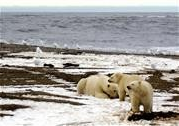
Canada lost some 1.2 percent of its water surface or 6700 square kilometers between 2000 to 2009 as revealed in a satellite survey of the 1.3 million lakes stretching from coast to coast, according to the International Arctic Research Center in Fairbanks, Alaska,
"It's an important finding. We need to find out what's driving it," says Larry Hinzman, director of the research center.
Previous surveys showed that there had been shrinking Arctic lakes, but only in the southern-most part of the Arctic. But the new survey, carried out by Mark Carroll at the University of Maryland in College Park found that the reverse is happening: it is the northern lakes that appears to be shrinking.
What is surprising, according to Hinzman, is that the northern region received higher-than-average amounts of rain during the 10-year study period. In addition, the warmer temperature across the region should be decreasing the snow pack which should also boost the lake. Despite these factors, however, the lakes are vanishing contrary to known physical processes that suggest that the lakes should be growing, not shrinking.
According to Hinzman, this could be a sign of climate change.
"It's over a large enough area that's its bound to have ecosystem and climate impacts," he said.
He noted that migratory water fowl, aquatic life, and indigenous people who rely on the lakes for food and water may all face challenges if the drying continues.
It was also observed that dried up lakes could affect the amount of greenhouse gases emitted by the region's ecosystem since the sediment in the newly exposed soil can release carbon dioxide.



And probably an indication that scientists (and/or reporters) like these are becoming extinct!
Really, what a laugh!